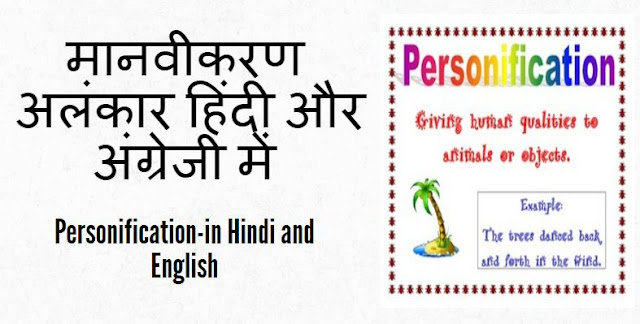मानवीकरण-अलंकार हिंदी और अंग्रेजी में – Personification-in Hindi and English

Contents
मानवीकरण-अलंकार हिंदी और अंग्रेजी में – Personification-in Hindi and English
Personification in English and Hindi:
Personification is a literary device where non-human objects, animals, or abstract concepts are given human qualities or characteristics. It is often used to create vivid imagery, evoke emotions, or make descriptions more engaging.
Personification in English:
Definition: When human attributes (like feelings, actions, or thoughts) are assigned to non-human entities (like objects, nature, or concepts).
Examples:
-
The wind whispered through the trees.
-
Here, the wind is given the human ability to “whisper.”
-
-
The sun smiled down on us.
-
The sun is being described as if it could smile, which is a human action.
-
-
Time flies when you’re having fun.
-
Time is given the human ability to “fly.”
-
-
The car roared to life.
-
The car is described as if it could roar like a lion.
-
-
The moon gazed down upon the quiet earth.
-
The moon is given the human action of “gazing.”
-
Personification in Hindi:
Definition: Personification (or व्यक्ति रूपक) in Hindi involves giving human traits or characteristics to non-human things, animals, or abstract concepts.
Examples:
-
हवा पेड़ो में फुसफुसाती है।
-
Here, the wind is given the human ability to “whisper” (फुसफुसाना).
-
-
सूरज हमारी ओर मुस्कराया।
-
The sun is given the human action of smiling (मुस्कराना).
-
-
समय उड़ता है जब हम मस्त होते हैं।
-
Time is given the human ability to “fly” (उड़ना).
-
-
कार ने दहाड़ते हुए चालू किया।
-
The car is given the human action of “roaring” (दहाड़ना).
-
-
चाँद पृथ्वी को निहार रहा था।
-
The moon is given the human action of “gazing” (निहारना).
-
Why is Personification Used?
-
Creates vivid imagery: It helps the reader imagine scenes more clearly.
-
Enhances emotional appeal: It evokes feelings and emotions by making inanimate objects relatable.
-
Makes writing more engaging: It adds a creative touch and brings inanimate things to life.
Conclusion:
Personification is a powerful literary tool that gives human qualities to things, making them more relatable or enhancing their significance. It works well in both English and Hindi to create a deeper connection between the audience and the subject being described.
Let me know if you’d like more examples or have any questions!
